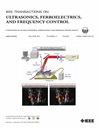A Multivariate Statistical Approach to Wrinkling Detection in Composites
IF 3
2区 工程技术
Q1 ACOUSTICS
IEEE transactions on ultrasonics, ferroelectrics, and frequency control
Pub Date : 2024-08-01
DOI:10.1109/TUFFC.2024.3436658
引用次数: 0
Abstract
Nondestructive inspection using ultrasound in materials such as carbon-fiber reinforced polymers (CFRPs) is challenging as the ultrasonic wave will scatter from each ply in the structure of the component. This may be improved using image processing algorithms such as the total focusing method (TFM); however, the high level of backscattering within the sample is very likely to obscure a signal arising from a flaw. Detection of wrinkling, or out-of-plane fiber waviness, is especially difficult to automate as no additional scattering is produced (as might be the case with delaminations). Instead, wrinkling changes how a signal is scattered due to the physical displacement of ply layers from their expected location. In this article, we propose a method of detecting wrinkling by examining the regional variations in image intensity, which are expected to be highly correlated between similar ply layers in the structure. By characterizing the 2-D spatial autocorrelation of an area surrounding a given location in the image of pristine components, the distribution of acceptable values is estimated. Wrinkling is observed to correspond with a significant deviation from this distribution, which is readily detected. A comparison is made with an alternative image processing approach identified from the literature, finding that the proposed method has equivalent performance for large wrinkling amplitudes and better performance for low wrinkling amplitudes.复合材料皱纹检测的多元统计方法。
在碳纤维增强聚合物(CFRP)等材料中使用超声波进行无损检测具有挑战性,因为超声波会从部件结构中的每一层散射出去。使用图像处理算法(如全聚焦法 (TFM))可以改善这一问题,但样品内部的高水平反向散射很可能会掩盖缺陷产生的信号。褶皱或平面外纤维波纹的检测尤其难以实现自动化,因为不会产生额外的散射(分层可能就是这种情况)。相反,褶皱会改变信号的散射方式,这是因为纤维层从其预期位置发生了物理位移。在本文中,我们提出了一种通过检查图像强度的区域变化来检测起皱的方法。通过描述原始部件图像中给定位置周围区域的二维空间自相关性,可以估算出可接受值的分布。通过观察可以发现,起皱与该分布的显著偏差相对应,而这种偏差很容易被检测到。通过与文献中的另一种图像处理方法进行比较,发现所提出的方法在处理大皱纹幅度时性能相当,而在处理小皱纹幅度时性能更好。
本文章由计算机程序翻译,如有差异,请以英文原文为准。
求助全文
约1分钟内获得全文
求助全文
来源期刊
CiteScore
7.70
自引率
16.70%
发文量
583
审稿时长
4.5 months
期刊介绍:
IEEE Transactions on Ultrasonics, Ferroelectrics and Frequency Control includes the theory, technology, materials, and applications relating to: (1) the generation, transmission, and detection of ultrasonic waves and related phenomena; (2) medical ultrasound, including hyperthermia, bioeffects, tissue characterization and imaging; (3) ferroelectric, piezoelectric, and piezomagnetic materials, including crystals, polycrystalline solids, films, polymers, and composites; (4) frequency control, timing and time distribution, including crystal oscillators and other means of classical frequency control, and atomic, molecular and laser frequency control standards. Areas of interest range from fundamental studies to the design and/or applications of devices and systems.

 求助内容:
求助内容: 应助结果提醒方式:
应助结果提醒方式:


